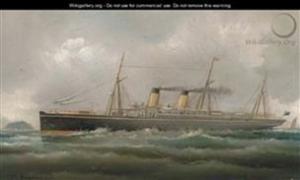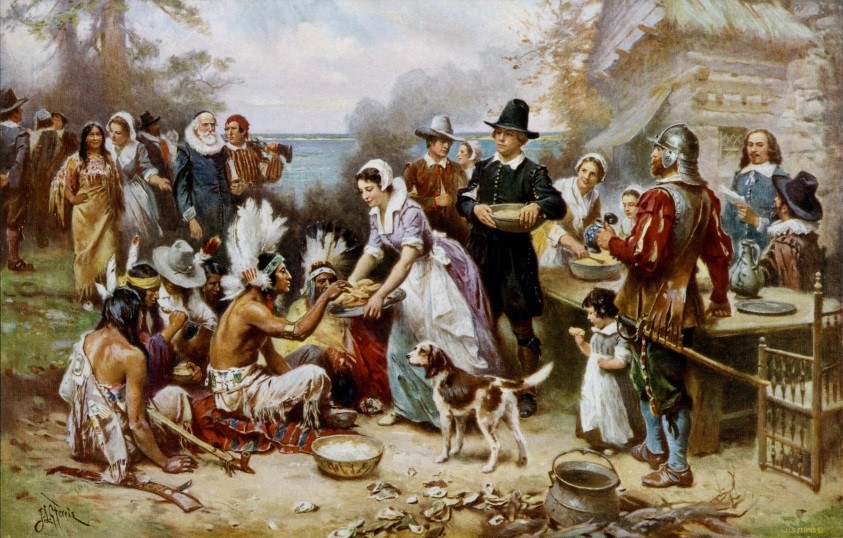It’s almost Thanksgiving Day and my thoughts turn to the story of the first Thanksgiving in America. It’s a story of a group of immigrants gathering to express gratitude to God and to the Native Americans for the help received in settling in a new land. For a genealogist, sooner or later the topic of immigration comes up because unless your ancestors were among those Native Americans who welcomed the Pilgrims, you have immigrant ancestors. In my own family history, my father’s parents were both born in Ireland while my mother’s ancestors came much earlier. For genealogists, making “the jump across the Pond” or in other words, finding when and from where their ancestors immigrated can be a challenge and sometimes even a frustration. The goal in tracing the immigration of your ancestor is to discover exactly where in the birth country your ancestor was born so that you know where to look for more records. There are a number of resources available to help you in your search and I will share some of them in this article.
First, there are two words that were helpful for me to learn. Emigration is leaving a country of origin and immigration is traveling to a new country. As you look for records, you will want to look for both emigration and immigration records. Germany is one of the countries for which there are a number of record bases available for people leaving Germany, with one of the best known being the Hamburg passenger lists. These lists include where in Germany the person originated and where they went. Ancestry.com has these records in searchable form and with the original record images.
The Learning Center at FamilySearch.org has a number of free online classes that will help you find the tools to trace the immigration of your ancestors. The Family Search Learning Center has filters in the right sidebar to help you find the classes that will be most helpful to you. From one of these classes I learned that knowing the religion of my immigrant Irish ancestors was important because the Catholics and the Protestants immigrated differently. Irish Protestants, especially in the mid-1800’s, usually migrated as a congregation with their minister as part of the group. Once in America, they tended to settle in the same town or village as a group. This can be helpful to know if you have trouble discovering exactly where your Protestant ancestor was born in Ireland because the neighbors were probably for the same place. If you can find records identifying where the neighbors came from, you likely have the place your ancestor came from as well. Irish Catholic immigrants were most likely to come by way of serial migration. The family would get together the money to send one family member to America. That person would come to America, get a job and send money back to Ireland so that another family member had the money to book passage to America.
You are probably familiar with Ellis Island and the many people who entered America through its doors. Their records are great and searchable online. But what if you can’t find your ancestor listed in the Ellis Island records? You will need to look for records from other American ports which are found the length of the Atlantic coast of the United States. Also, emigrants from the British Isles would often come to a Canadian port because for them it was less expensive. They would then enter the United States through the Canada-United States border. The port of New Orleans, Louisiana was also a gateway to those headed for the mid-western states. From New Orleans, immigrants would take riverboat north. Traveling on a riverboat was not for the faint-hearted. Riverboats were made of wood and powered by a coal-fired steam engine. Riverboats catching fire were a frequent occurrence which made the trip up the Mississippi River more dangerous than the trip across the Atlantic Ocean!
 My father’s parents entered the United States through Ellis Island separately and as teenagers. Ellis Island records give you access to the passenger list that was part of the ship’s manifest which will give you additional information about your ancestor. Also available will be a picture of the ship which they traveled. I found it interesting that my grandparents happened to travel on the same ship, the Teutonic, two years apart.This is the ship’s manifest that records my grandfather,
My father’s parents entered the United States through Ellis Island separately and as teenagers. Ellis Island records give you access to the passenger list that was part of the ship’s manifest which will give you additional information about your ancestor. Also available will be a picture of the ship which they traveled. I found it interesting that my grandparents happened to travel on the same ship, the Teutonic, two years apart.This is the ship’s manifest that records my grandfather,
Cornelius O’Neill entering the United States through Ellis Island in 1906
 Cornelius O’Neill is on line 24 and his occupation is listed as clerk. He paid for his own passage and had twenty-three dollars with him, which was a lot of money in 1906. Finding this record was a surprise for me since my grandfather, Cornelius, told his children that he had sneaked into this country by working his way across the Atlantic on a steamship and when the ship docked he walked away and never returned to the ship.
Cornelius O’Neill is on line 24 and his occupation is listed as clerk. He paid for his own passage and had twenty-three dollars with him, which was a lot of money in 1906. Finding this record was a surprise for me since my grandfather, Cornelius, told his children that he had sneaked into this country by working his way across the Atlantic on a steamship and when the ship docked he walked away and never returned to the ship.
Your ancestors immigrated for a variety of reasons but for all of them there was likely a feeling of regret for loved ones they were leaving behind. This Irish ballad written by Paul Kealy expresses it well.
I invite you to explore your ancestor’s immigrant journey and consider their circumstances and the emotions they might have felt. I hope that you, like me, will gain a greater understanding of the ancestor whose immigration journey you trace. If you will share Thanksgiving dinner with older members of your family, I hope you will take the opportunity to gather more stories about your family. If you know the immigration story of one of your ancestors, I would love to hear it.
About Christine Bell
Christine Bell has been seeking her ancestor for almost forty years and continues to find joy in each one she finds. She volunteers in a Family Search Family History Center where she helps others find their ancestors. As a convert to The Church of Jesus Christ of Latter-Saints, she is grateful to be a member of the Church. She is a wife, mother of six grown children, grandmother of five going on six, and currently living in the western United States. Christine enjoys spending time with family and creating quilts for family, friends and Humanitarian Services of The Church of Jesus Christ of Latter-day Saints.




